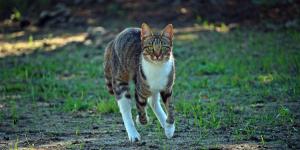Do Cats Always Land on Their Feet?



See files for Cats
Have you ever witnessed your cat take a daring leap and land seemingly unscathed? It's no wonder the saying goes that "cats always land on their feet." But is this feline feat truly a magical superpower, or is there more to the story?
This AnimalWised article dives deeper than the popular saying to explore the science behind a cat's righting reflex. We'll uncover the truth about whether cats always land on their feet.We'll uncover the conditions that allow cats to twist and land gracefully, as well as the limitations of this incredible ability. Additionally, we'll provide valuable tips to keep your curious cat safe and minimize the risk of falls.
Is it true that cats always land on their feet?
The popular saying goes that "cats always land on their feet," but that's not entirely accurate. Cats have a remarkable ability called the righting reflex that allows them to twist their bodies mid-air and attempt a feet-first landing in most falls. However, this reflex has limitations, which will be explored in the following sections.
The notion that cats possess an infallible ability to always land on their feet is a widely held belief. However, the reality is more nuanced. Cultures like ancient Egypt revered cats, often depicting them in ways that emphasized their agility. These artistic representations, in turn, may have contributed to the development of the myth.
Around the world, various cultures have incorporated cats' perceived ability to land safely from falls into their folklore. This association is further strengthened by the myth of cats having nine lives, implying exceptional resilience.
Moving on to more recent times, anecdotal evidence continues to fuel the myth. Cat owners frequently report witnessing their pets righting themselves during falls from seemingly dangerous heights. Videos and news stories often showcase instances of cats falling from significant heights and seemingly escaping unharmed. However, it's important to note that anecdotal evidence can be subjective and may not represent the full picture.
Want to learn more about your feline friend's predatory instincts? Check out this article exploring cat hunting behavior.

How do cats always land on their feet?
Cats possess a remarkable ability to right themselves during falls, often landing on their feet. This ability isn't foolproof, but it's a fascinating example of feline agility. Let's explore the biological mechanisms behind this behavior.
Unlike humans with a rigid spinal column, cats have a spine composed of numerous vertebrae. This flexibility allows for incredible twisting mid-air, a crucial element for righting themselves during a fall. Such flexibility not only grants them exceptional balance but also allows them to contort their bodies to navigate tight spaces while climbing. Additionally, their hind legs are well-muscled, providing the explosive power needed for propelling themselves upwards during leaps.
A cat's inner ear houses the vestibular apparatus, a system responsible for balance and spatial orientation. This system detects changes in head position and movement, helping the cat maintain its sense of "up" and "down" even when falling. This information is then used to adjust the body's position for a more controlled landing.
A cat's body shape plays a role in aerial maneuvers. The elongated torso and low center of gravity create a streamlined design, minimizing air resistance and optimizing movement during a fall. Additionally, the tail acts as a rudder, aiding in steering and maintaining balance during mid-air rotations. Fluffing the tail, for example, creates slight drag, offering some control over descent speed.
The principle of conservation of angular momentum comes into effect when a cat falls. This principle states that a rotating object will maintain its spin unless acted upon by an external force. During a fall, a cat instinctively twists its head and neck, initiating rotation of the upper body. This rotation then influences the rest of the body, potentially allowing it to turn and land on its feet.
It's important to remember that the righting reflex has limitations. The height of the fall, the landing surface, and the cat's physical condition can all influence the outcome. High falls can still result in injuries despite the reflex.

Limitations of the cat righting reflex
While impressive, a cat's righting reflex isn't foolproof, falls can still be dangerous and lead to injuries, especially from significant heights. Several factors can hinder their ability to land gracefully, and sometimes, gravity wins. Let's explore these limitations:
- Height of the fall: the righting reflex requires sufficient height to allow the cat to twist its body. Short falls may not provide enough time for a complete rotation, potentially leading to a bumpy landing.
- Surface the cat lands on: a firm, even surface is ideal for the reflex to work effectively. Landing on uneven terrain, thick foliage, or water can disrupt the twisting motion and increase the risk of injury.
- Cat's physical condition and age: kittens haven't fully developed their righting reflex, and older cats may experience decreased flexibility or balance issues. Additionally, injuries, illness, or obesity can limit a cat's ability to perform the mid-air maneuvers.
Curious why your cat seeks out the highest nooks for naps? This other AnimalWised article explores the fascinating reasons behind a feline's love for lofty sleeping spots.
What happens if a cat doesn't land on its feet?
Cats are natural climbers with an insatiable curiosity. This often leads them to explore exciting new places like balconies or windows.
It's important to understand that these forays provide enrichment and enjoyment for your feline friend. However, balconies can be dangerous for cats. Falls, even from seemingly low heights, can cause serious injuries.
The best way to keep your cat safe while enjoying the outdoors is to install a mesh or safety net on your balcony. This creates a secure enclosure, allowing your cat to explore the fresh air without the risk of falling. Repeated falls from balconies are sometimes referred to as "parachute cat syndrome." However, it's important to remember that these falls are very dangerous.
If your cat falls:
- Assess the situation: check for any obvious injuries like broken bones or bleeding.
- First aid (if possible): if you can do so safely, administer basic first aid, such as stopping any bleeding with gentle pressure.
- Veterinarian immediately: seek professional veterinary care as soon as possible. A vet can thoroughly examine your cat for internal injuries and ensure its proper recovery.
Even with some luck on their side, a cat that doesn't land perfectly can sustain a variety of injuries, including:
- Broken bones
- Sprains
- Internal injuries
- Lung contusions
- Head trauma
After a fall, take steps to prevent future incidents. This could involve installing safety measures like cat trees with proper landings, or restricting access to balconies and windows. It's always better to be safe than sorry. Providing a safe environment for your feline friend can significantly reduce the risk of falls and potential injuries. Explore essential tips on cat netting for balconies and windows in this other informative article.

If you want to read similar articles to Do Cats Always Land on Their Feet?, we recommend you visit our Facts about the animal kingdom category.








